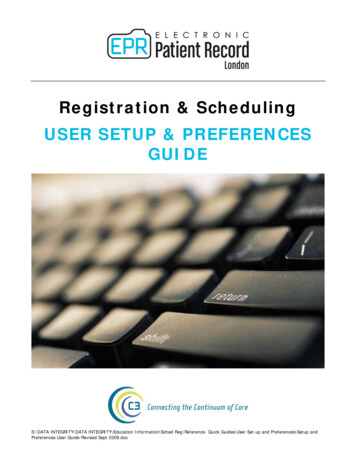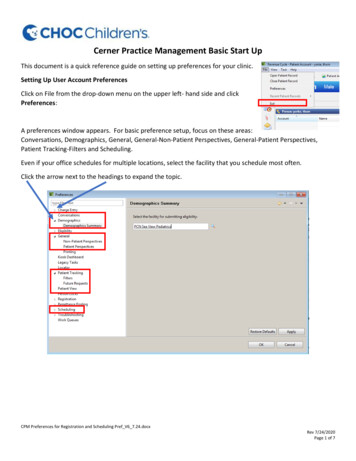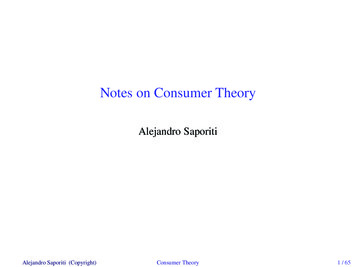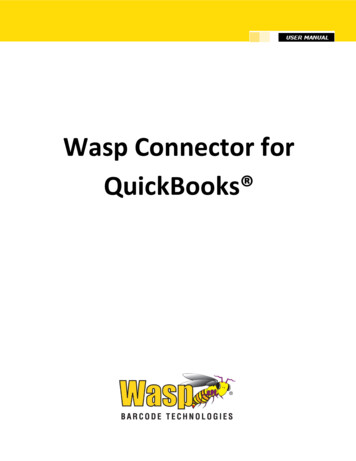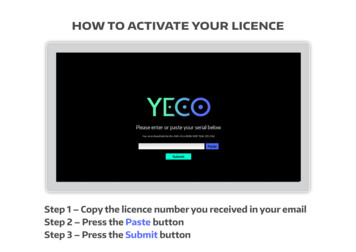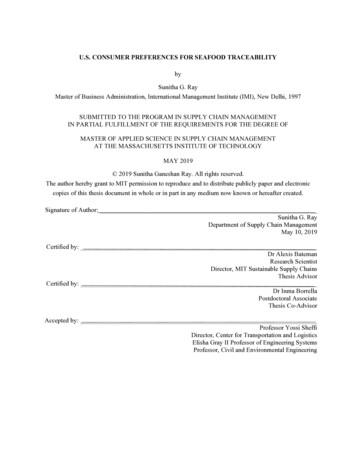
Transcription
U.S. CONSUMER PREFERENCES FOR SEAFOOD TRACEABILITYbySunitha G. RayMaster of Business Administration, International Management Institute (IMI), New Delhi, 1997SUBMITTED TO THE PROGRAM IN SUPPLY CHAIN MANAGEMENTIN PARTIAL FULFILLMENT OF THE REQUIREMENTS FOR THE DEGREE OFMASTER OF APPLIED SCIENCE IN SUPPLY CHAIN MANAGEMENTAT THE MASSACHUSETTS INSTITUTE OF TECHNOLOGYMAY 2019 2019 Sunitha Ganeshan Ray. All rights reserved.The author hereby grant to MIT permission to reproduce and to distribute publicly paper and electroniccopies of this thesis document in whole or in part in any medium now known or hereafter created.Signature of Author:Sunitha G. RayDepartment of Supply Chain ManagementMay 10, 2019Certified by:Dr Alexis BatemanResearch ScientistDirector, MIT Sustainable Supply ChainsThesis AdvisorCertified by:Dr Inma BorrellaPostdoctoral AssociateThesis Co-AdvisorAccepted by:Professor Yossi SheffiDirector, Center for Transportation and LogisticsElisha Gray II Professor of Engineering SystemsProfessor, Civil and Environmental Engineering
U.S. CONSUMER PREFERENCES FOR SEAFOOD TRACEABILITYbySunitha G. RaySubmitted on May 10, 2019 in Partial Fulfillment of theRequirements for the Degree of Master of Applied Science in Supply Chain ManagementABSTRACTAmericans are the second largest consumers of seafood globally but more than 90% of the seafoodconsumed is imported, causing the seafood supply chain to be long, opaque, and complex. This givesrise to several concerns such as intentional mislabeling, species substitution, illegal unreported andunregulated (IUU) fishing, unsustainable fishing practices and human rights violations in the seafoodindustry. Despite recent government mandates and initiatives such as the Seafood Import MonitoringProgram (SIMP) as well as advocacy from industry and supply chain players, end-to-end informationflows from harvest location to the table, remains a challenge. This is mainly due to lack of commonharmonized Key Data Elements (KDEs), lack of interoperability, lack of global adoption ofstandards, and heterogenous systems. Traceability appears to provide a mechanism to alleviate theseconcerns through enabling information flows triggered by three major drivers of seafood traceability:producers, consumers and regulators. Of the three, consumers are perceived to have the leastinfluence on traceability.This paper investigates whether consumer preferences can drive seafood traceability. It also exploresspecific consumer characteristics and preferences for whole-chain traceability through direct survey,interviews with industry stakeholders and review of existing literature. The survey results show thatconsumer preferences play a lesser role as compared to other drivers, due to several exogenousreasons. However, further analysis shows that high propensity for traceability preferences may beinfluenced by high income levels, frequency of consumption and domicile habitats closer to urbanand coastal areas in the U.S. Steps towards establishing an integrated, collaborative and inclusiveapproach to standardization of KDEs may help move the seafood traceability agenda forward.2
ACKNOWLEDGMENTSI would like to thank my husband for fully supporting me in my academic pursuit, despite goingthrough his severe health crisis and my son without whose encouragement I could have notaccomplished this paper. I also thank my brothers, parents, sisters-in-law and my nieces forsupporting and motivating me through this difficult time. No words can express the gratitude I feelfor them.I would like to thank my advisor, Dr. Alexis Bateman, for making the time amongst all the otherimportant work to provide guidance and direction towards this endeavor that is important to mepersonally. I would like to thank my co-advisor, Dr. Inma Borrella for her inputs and support. Iwould like to thank Dr. Josue Velasquez for his support and the staff at MIT’s CTL for being a sourceof inspiration on this journey and creating this amazing program.I am thankful to my colleagues who made the time to give me their valuable insights from thefollowing organizations: Ahold Delhaize, Kroger, Gulf of Maine Research Institute, World WildlifeFund, Food Marketing Institute, FDA, GS1 and Fishcoin. I am grateful to my partners at Walmartfor giving me the opportunity to engage in the exciting field of data attributes in the first place.Finally, I want to thank my classmates of my SCM Blended Program Class of 2019 for being asource of joy and always being there to be counted upon.3
List of FiguresFigure 1: Volume of wild-caught and farmed seafood, 1950-2012. Source: FAO (2014). 8Figure 2: Schematic drawing of the seafood supply chain from producers to the end consumer. 9Figure 3: Average annual food recall events by food category, 2004-2013. Source: USDA . 14Figure 4: Schematic diagram of blockchain based seafood traceability. Source: Fishcoin, 2018. . 18Figure 5: Seafood traceability information flows based on drivers . 21Figure 6: Principal Component Analysis of Clusters . 32Figure 7: Respondents' demographic information . 34Figure 8: Demographics by education levels . 34Figure 9: Result - Consumers' purchasing factors by income levels. 36Figure 10: Result – Consumers’ purchasing factors by domicile habitat . 37Figure 11: Result - Certification preferences across education levels . 37Figure 12: Result - Consumption patterns by frequency of consumption . 37Figure 13: Result - Consumer concerns per education and income levels . 38Figure 14: Result - Seafood trust by gender . 38Figure 15: Result - High traceability preferences by gender . 39Figure 16: Result - Seafood Trust Factors per education levels . 39Figure 17: Result – Seafood Trust Factors per domicile habitat . 40Figure 18: Result - Marginal premium for traceable attributes across education levels . 41Figure 19: Result - Location KDE preferences . 42Figure 20: Result - Location KDEs by education levels . 42Figure 21: Result - Naming KDEs per income levels . 42Figure 22: Result - High traceability preferences by education levels and gender . 43Figure 23: Result - Income Levels . 44Figure 24: Result - Education levels . 44Figure 25: Frequency of Consumption . 44Figure 26: Classification Tree . 45Figure 27: Result - Cluster and Probability Analysis . 47Figure 28: Intersection of all drivers . 544
List of TablesTable 1: k-Means Clustering Methodology . 32Table 2: Classification Tree Methodology . 33Table 3: Supply Chain Stakeholders Interviews . 36Table 4: KDE-wise Classification Trees . 46Table 5: Potential impact of traceability on information governance based on traceability drivers 52Table 6: Integrated approach combining drivers for seafood traceability . 55Table 7: Seafood consumption. Source: FMI 2019. 755
Contents1. Introduction . 81.1Background . 81.2Why Traceability? . 91.3What is Driving Traceability? . 101.4Current Knowledge Gap . 111.5Research Objective and Summary . 122. Literature Review . 132.1The Case for Seafood Traceability . 132.2Seafood Traceability Concepts . 152.2.1 What is traceability? . 152.2.2 Technology as an enabler of seafood traceability . 162.2.3 Data Standards Related to Seafood Traceability. 182.3Drivers of Traceability. 202.3.1 Management Driver . 212.3.2 Regulatory Driver. 232.3.3 Consumer Driver . 242.4Gaps in Literature Review . 252.6Thesis Objectives . 253. Methodology. 263.1Study Design . 263.1.1 Primary Research: Direct Survey . 263.1.2 Primary Research: Stakeholder Interviews . 283.1.3 Secondary Research: Thematic Content Analysis . 283.2Analysis Methods . 293.2.1 Quantitative Analysis . 293.2.2 Machine Learning Detailed Methodology . 314. Results . 344.1Respondents’ Profiles . 344.2Findings and Analysis . 354.1.1 Qualitative findings from stakeholder interviews and focus groups . 354.1.2 Consumers consumption and purchasing patterns . 366
4.1.34.1.44.1.54.1.64.1.74.1.84.1.9Seafood consumption patterns . 37Consumers prefer freshness of seafood . 38What makes consumers trust seafood authenticity? . 38Marginal premium for traceability . 41Consumer demographics plays a role in traceability preferences . 41Premium prices on traceable seafood . 43Cluster and Classification Tree Analyses . 455. Discussion . 485.1.Perspectives . 485.1.1 Key inferences from research . 485.1.2 Recommendations for seafood traceability drivers . 505.1.3 Traceability as an informational governance tool . 535.1.4 Common Interoperable Key Data Elements (KDEs) vocabulary . 535.1.5 Integrated approach to traceability . 545.1.6 Managerial Implications . 545.1.7 Policy Implications . 565.1.8 Consumer Implications . 575.2Conclusion . 585.3Limitations . 595.4Future research . 60References . 61Appendix A . 66Appendix B . 68Appendix C . 757
1. Introduction1.1 BackgroundSeafood consumption has grown progressively since the 1950’s. Global fish production peaked atabout 171 million tons in 2016 (Figure 1), with that production evenly distributed between wildseafood in the world. Fishing andTotal wild-caught supplyTotal farmed supplyseafood consumption in the 196619621958States increased in 2017 to 00020,000,00001950Volume (metric tons)catch and aquaculture (FAO, 2018). The United States (U.S.) is the second largest consumer ofFigure 1: Volume of wild-caught and farmed seafood, 1950-2012.Source: FAO (2014)billion pounds (US 5.4 billion)annually, an increase of 3.6 percentfrom the year before. The seafood industry, which consists of fishing, seafood farming andprocessing sectors, forms a significant part of the U.S. economy. In 2016, the seafood industrycontributed 100 billion to the U.S. GDP and supported 1.7 million jobs in the country (NOAA,2017).In recent years, with increasing per capita income, more millennials entering the work force, and agreater focus on health and fitness, there is a shift to healthier, higher protein-based food. Seafood,a lean source of protein and essential nutrients, rich in Omega 3 and Omega 6 fatty acids, has beencalled “nature’s super food” for its nutritional components (FAO, 2016).The majority of seafood consumed in the U.S. today, between 85 to 95 percent is imported (NOAA,2017). This lends a high level of opaqueness to the global seafood industry creating several8
challenges such as: intentional species substitution,illegal unreported and unregulated (IUU) fishing, comingling of seafood species?, high incidence offoodborne illnesses, fraudulent labeling, unsustainablefishing practices and human rights violations. As aresult,these issues threatenfoodsafetyandsustainability. The seafood supply chain’s complexityis magnified due to the highly perishable nature of liveand fresh seafood, proliferating product segments(wild-caught, aquaculture and processed acrossseafood products:Figure 2: Schematic drawing of the seafoodsupply chain from producers to the end consumer.fish, crustaceans and shellfish),ever-increasing tiers of diverse suppliers (Figure 2), and lack of seamless communication betweenthem. There also exists a dearth of harmonized rules and globally accepted standards for seafooddata attributes, which poses the biggest challenge in whole-chain transparency in the seafoodindustry. For example, it is possible for fishermen to legally sell Warsaw grouper, identified as acritically endangered species by the International Union for Conservation of Nature (IUCN), assimply “grouper,” making it difficult to differentiate it from the 64 other fish that can be sold asgrouper.1.2 Why Traceability?Safety is an important quality attribute of seafood (FAO, 2018). Consumers’ food safety perceptionsinfluence their seafood consumption and purchase patterns. Some segments of consumers areincreasingly demanding high standards of quality assurance and ascertainment that the fish they9
purchase are produced sustainably and with quality certifications (Rahmaniya & Sekharan, 2017).These segments want to know more about where their fish originated from, who the suppliers are,whether they are sustainably farmed or caught and whether they are safe to feed their families. Theywant to gain trust about the safety and authenticity of the seafood they consume. In other words, theinformation flows surrounding the physical and financial flows of products have been gainingprominence. Transparency in end-to-end accurate, trusted, real time information as food movesthrough the supply chain can build trust with consumers (Mol, 2015).Traceability does appear to provide a mechanism to alleviate these concerns through enablingstructured information flows across the entire value chain (Bailey, Bush, Miller, & Kochen, 2016).However, the lack of consistent data standards, unharmonized global regulations, lack ofinteroperability between systems of record and lack of a common data vocabulary causeimpediments in whole chain information flows (A. Naaum & Hanner, 2016). The Global FoodTraceability Center (GFTC) lead the Interoperable Seafood Traceability Technology ArchitectureProject, with an aim to establish a harmonized, secure, interoperable seafood traceability system(Bhatt et al., 2016). It recommends a universal list of Key Data Elements (KDEs) at various producttransformation touchpoints or Critical Tracking Events (CTEs) clustered by various drivers oftraceability.1.3 What is Driving Traceability?Effective seafood traceability systems are dependent on various underlying drivers: (a) governmentregulation of seafood and its safety, (b) consumer-facing and brand aware supply chain actors, and(c) consumers who demand to know more about the credence attributes of their seafood (Bailey etal., 2016). Credence attributes are quality attributes which are desired by consumers. Consumers10
have to rely on other sources such information on their products or other sources of information asmedia and word of mouth (Becker, n.d.). A recent transparency survey found that consumers wantto see everything from a complete ingredient breakdown to sourcing information, with 94% ofrespondents saying they are likely to be more loyal to a brand that offers complete transparency(Label Insight, 2016). Information flow to consumers of seafood product characteristics like harvestdate, quality, origin and processing information are communicated through product labeling andthrough chain of custody information systems via the retailer and product labeling. These “credence”attributes along with eco-labels and certifications, are difficult for consumers to obtain and are not apriority today. Consumer preferences are regarded as insignificant according to traceabilityliterature. However, consumers could be a major driver of change in the behavior in the industry, farexceeding past-campaigns such as “dolphin-safe” tuna and bans on shark fin soup (Willette andCheng, 2018).1.4 Current Knowledge GapWhile there exists a significant literature examining consumer preferences for seafood and credenceattributes, attitudes and beliefs related to U.S. seafood consumption, consumer preferences fortraceable information and attitudes towards traceable KDEs are not well understood (Mol, 2015).Even with the recent U.S. regulations mandating comprehensive seafood import data, there still areopen questions and gaps in that the information gathered does not specify unique attributes such asspecific fishing methods, processing steps, scientific nomenclatures, and additional credenceattributes (He, 2018). There is paucity of data or research about consumers’ likeliness to engage intraceability and what motivates them to trace their products (A. Naaum & Hanner, 2016).11
1.5 Research Objective and SummaryThe goal of this paper is to understand the existing literature and the current research around seafoodtraceability from the perspective of drivers in general and consumer preferences, particularly in theU.S. It highlights consumer attitudes and perceptions associated with seafood buying behaviorthrough direct survey, stakeholder interviews, and focus groups. It examines the influence ofconsumer preferences on traceability KDEs through statistical analysis, classification, clustering,data visualization and machine learning analysis. It answers the key questions: Do consumerpreferences drive seafood traceability in the U.S.? What specific consumer characteristics,perceptions and attitudes spur high traceability KDEs? The paper further discusses the implicationsof the findings to the seafood industry stakeholders and recommendations to strengthen the valueproposition and foster adoption of traceability systems.This research paper is organized into 5 Sections. Section 2 summarizes a thematic representation ofexisting literature in this area. Section 3 explains the research methodology. The results and findingsfrom the research are elaborated in Section 4 followed by discussion, recommendations andconclusion in Section 5.12
2. Literature ReviewThe literature review was conducted in advance of the primary research to determine the needs anddrivers of traceability. This chapter provides a synopsis of existing literature surrounding seafoodtraceability concepts, drivers of seafood traceability and consumer preferences towards traceability.2.1 The Case for Seafood TraceabilityWhen we think of seafood, we think of the fisher folk who catch or farm the fish, but there are manydiverse global supply chain players, from the smallest fishermen and aquaculture farmers toprocessors, distributers, producers, manufacturers, and other intermediaries. Seafood has aparticularly long, opaque, and complex journey as it travels through the global supply chain to theU.S., which causes challenges.The global problem of Illegal, unreported and unregulated (IUU) fishing results in an estimatedfishing loss of 10 billion to 23.5 billion per year, representing 11 to 26 million tons of seafood(Agnew et al, 2009). In the United States, IUU products account for 1.3 billion to 2.1 billiondollars of wild caught seafood imports (Pramod, Nakamura, Pitcher, & Delagran, 2014).Additionally, it also causes biodiversity loss and decreased food security (FAO, 2018). IUU has alsobeen implicated in slave and human trafficked labor . In 2014, a major investigation revealingbrutal cases of slavery aboard fishing boats in Thailand caused international furor (Kelly A., 2018).13
Seafood fraud, or intentional mislabeling of species name is rampant. For example, three recentDNA-based surveys of Los Angeles (California) restaurants found mislabeling rates of up to 52%when DNA results were compared with the U.S. Food and Drug Administration (FDA) list ofacceptable market names and retail names. Results show that when scientific (Latin) speciesdenomination is not mandatory, seafood labeling rules and controls are inadequate. Mislabeling inhigh-end grocery stores was also identified but at a slightly lower frequency (42%) than restaurants(Wilmette et al, 2017).Mislabeling also allows contaminated fishproducts to enter the market. The average annualfood recall events have increased by 71% from2004-2008 to 2009-2013 (Figure 3). CDC (2015)reports that seafood caused about 36% offoodborne illnesses in the US in 2013. SeafoodFigure 3: Average annual food recall events by foodcategory, 2004-2013. Source: USDAfraud and lack of traceability systems, account fordamaging health effects. Even when some mechanisms exist for food safety assurance, there is lackof monitoring, transparency, trace-back and accountability in the seafood supply chain (Pramod etal., 2014).Seafood is a highly perishable product, with a short shelf life. Even with expensive refrigeratedstorage and tanks, nearly 20% of seafood spoils before it reaches its end customer. For example,fishermen are often forced to accept low prices because of the obsolescence risk involved in holdingout for a better price. At any point of time, the supply chain player holding the inventory is vulnerableto weather impacts and cold chain infrastructure conditions (Pramod et al., 2014). This power14
equation can sometimes drive suppliers to resort to extreme measures—such as mislabeling productor purchasing illegal product or encouraging unsustainable fishing methods.2.2 Seafood Traceability Concepts2.2.1 What is traceability?Traceability can be defined as “the ability to systematically identify a unit of production, track itslocation and describe any treatments or transformations at all stages of production, processing anddistribution” (Magera, Beaton, & Ecology Action Centre, 2009). It is the ability to track and traceproduct at every stage of the food chain, where the food came from (one step back) and where thefood went to (one step forward). This is called the “one-up, one-down” system or OUOD. OUODwas part of a science-based minimum standards for preventive food safety practices, provideoversight and compliance through mandated inspections, respond effectively through mandatoryfood recalls, enhance record-keeping and establish a food product tracing system (FDA, 2017). Inthe seafood industry, Chain-of-Custody (CoC) provides a useful integrating framework forunderstanding efforts to reduce public health concerns surrounding the consumption of seafood. Atraceability system which facilitates retrieval and access to information along a chain-of-custody iscore concept to ensuring seafood supply chain transparency and risk mitigation (Yasuda & Bowen,2006).A traceability system should be able to (a) provide access to all properties of a food product; (b)provide access to all properties of a food product or ingredients in all its forms, in all links in thesupply chain, not only on production batch level; and (c) facilitate traceability backwards andforwards (Olsen & Borit, 2018). Therefore, a comprehensive food traceability solution must have15
the following characteristics: (a) unique identification of the food product at granular levels; (b)chronological registration of product information as it transforms or moves through the supply chain;(c) tracking and linking of all this registration information, so it forms a forward and backward trail;(d) harmonization and integration of this data as per global standards; and (e) transparency andcommunication of this information to achieve effective seafood traceability data governance.Traceability can proactively provide a means for food safety and quality assurances by reducing thesize and scope of recall (Bailey et al., 2016). Seafood traceability also may promote sustainablemanagement of fisheries, which by itself is a global problem that challenges the balance of marineecosystems and seafood supply for future generations. A survey of 9 global seafood producersidentified greater commercial benefits of traceability when businesses more tightly integrate it intotheir value chains (Sterling et al., 2015). The benefits derived from traceability include improvedsupply chain management, reduced mislabeling and seafood fraud, regulatory enactments to deterIUU fishing such as import laws like those stipulated by the EU and FDA in the US, improved qualityand better market differentiation.2.2.2 Technology a
Requirements for the Degree of Master of Applied Science in Supply Chain Management ABSTRACT Americans are the second largest consumers of seafood globally but more than 90% of the seafood . Ahold Delhaize, Kroger, Gulf of Maine Research Institute, World Wildlife Fund, Food Marketing Institute, FDA, GS1 and Fishcoin. I am grateful to my .







